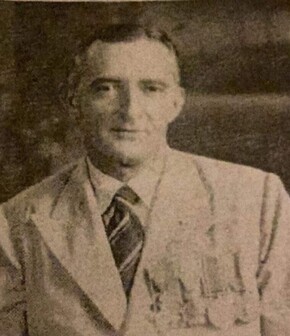MULLALY, John Charles
| Service Numbers: | 5102, VX108390 |
|---|---|
| Enlisted: | 13 October 1939 |
| Last Rank: | Lieutenant Colonel |
| Last Unit: | Pacific Iaslands, Depot Battalion |
| Born: | Melbourne, Victoria, Australia, 3 September 1895 |
| Home Town: | Not yet discovered |
| Schooling: | Not yet discovered |
| Occupation: | Not yet discovered |
| Memorials: |
World War 1 Service
| 2 Feb 1915: | Embarked Private, 5102, 3rd Light Horse Brigade Train, HMAT Chilka, Melbourne | |
|---|---|---|
| 2 Feb 1915: | Involvement Private, 5102, 3rd Light Horse Brigade Train, --- :embarkation_roll: roll_number: '22' embarkation_place: Melbourne embarkation_ship: HMAT Chilka embarkation_ship_number: A51 public_note: '' |
World War 2 Service
| 13 Oct 1939: | Enlisted Australian Military Forces (WW2) , Lieutenant Colonel, VX108390 | |
|---|---|---|
| 28 Oct 1946: | Discharged Australian Military Forces (WW2) , Lieutenant Colonel, Pacific Iaslands, Depot Battalion |
Help us honour John Charles Mullaly's service by contributing information, stories, and images so that they can be preserved for future generations.
Add my storyBiography contributed by Aubrey Bairstow
John “Jack” Charles Mullaly was born in Hawthorn, Victoria in 1895. He enlisted in the AIF aged 19 in October 1914, stating that his occupation was clerk. John stated that he had had 15 months prior infantry service.
He was posted to 1 Light Horse Regiment but whilst in Egypt he was transferred to the 1st Army Pay Corps. He left for England in May 1916 and after training proceeded overseas to France as a Corporal in July 1917. He was posted to the 43rd Battalion and was wounded in action at Ypres on 5 October 1917 – the nature of his wounding was a gun shot wound to the back (listed as severe). His recovery in England took 6 months and he did not return to France until April 1918, as a Temporary Sergeant.
In September 1918 he was selected as an officer cadet and he was commissioned as a 2nd Lieutenant in January 1919. He returned to France as an officer and was promoted to Lieutenant later that year. Finally, in October 1919 he returned to Australia.
He settled in Melbourne where his medal trio was issued to him. In 1921 he was working as Inspector, Expropriation Board in New Guinea and in 1924 he was Inspector of Native Affairs.
He became very active in New Guinea matter and by 1925 was a Magistrate. The following year he commenced planting at Natava Plantation and trading and was a founder member of the Planters Association – of which he was Vice President 1930-31 and President 1932-39.
He married a Nurse, Ruth Saunders from NSW in New Guinea in 1926.
“He played a major role in the planters' efforts to break the oligopoly in the copra industry of the big trading companies, Burns, Philp & Co. Ltd. and W. R. Carpenter & Co. Ltd. Because of low world market prices for copra, many of the Australian ex-servicemen on expropriated properties were in financial difficulties. After the association's appeal to the Federal government, they were granted a moratorium and payments were suspended from July 1930 to June 1936.
When the New Guinea Legislative Council was established Mullaly was appointed one of the non-official members (1933-45) and the non-official member of the Executive Council (1933-39). In the Legislative Council in 1940 he pressed for government control and marketing of copra through a statutory authority.” Australian Dictionary of Biography
In 1937 there was a very destructive eruption at Rabaul and for his services he was awarded the Order of the British Empire (Civil) in December of that year. Vulcan and Tavurvur at Rabaul erupted simultaneously killing 507 people and injuring countless more in June 1937. As a result Australia moved its New Guinea operations to Lae.
Jack enlisted in the New Guinea Volunteer Rifles as Lieutenant and Adjutant in October 1939 (service number V17965) and in 1941 returned to Australia to take up a commission as a Captain as the Australian Intelligence Corps. He was allocated the service number VX108390. At the time he was reported as being “one of the most prominent public men in the territory”. His knowledge of New Guinea was considered vital and he was posted to GHQ of the South West Pacific based in New Guinea. From 1942-44 he was Director of the Combined Operations Intelligence Centre, working from a non-descript hut in Port Moresby for G Branch, Australian Directorate of Military Intelligence. He was promoted to Temporary Lieutenant Colonel in August 1943. He later returned to the PNGVR in January 1945 and was Lt Colonel of the Pacific Islands Regiment and New Guinea Regiment until his eventual retirement in late 1946.
One can imagine his importance to the Japanese had he been captured. For his WW2 services he was awarded the Pacific set of 4, all named VX108390 but surprisingly no decoration.
He settled in Gordon, New South Wales and died at Mossman in 1977










